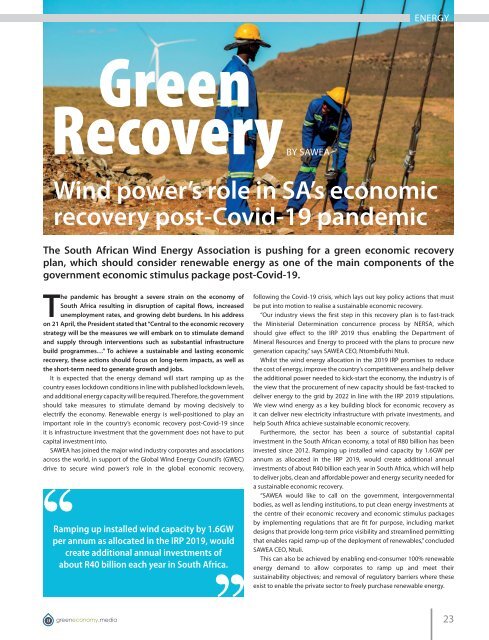Green Economy Journal Issue 41
You also want an ePaper? Increase the reach of your titles
YUMPU automatically turns print PDFs into web optimized ePapers that Google loves.
ENERGY<br />
<strong>Green</strong><br />
Recovery<br />
BY SAWEA<br />
Wind power’s role in SA’s economic<br />
recovery post-Covid-19 pandemic<br />
The South African Wind Energy Association is pushing for a green economic recovery<br />
plan, which should consider renewable energy as one of the main components of the<br />
government economic stimulus package post-Covid-19.<br />
The pandemic has brought a severe strain on the economy of<br />
South Africa resulting in disruption of capital flows, increased<br />
unemployment rates, and growing debt burdens. In his address<br />
on 21 April, the President stated that “Central to the economic recovery<br />
strategy will be the measures we will embark on to stimulate demand<br />
and supply through interventions such as substantial infrastructure<br />
build programmes…” To achieve a sustainable and lasting economic<br />
recovery, these actions should focus on long-term impacts, as well as<br />
the short-term need to generate growth and jobs.<br />
It is expected that the energy demand will start ramping up as the<br />
country eases lockdown conditions in line with published lockdown levels,<br />
and additional energy capacity will be required. Therefore, the government<br />
should take measures to stimulate demand by moving decisively to<br />
electrify the economy. Renewable energy is well-positioned to play an<br />
important role in the country’s economic recovery post-Covid-19 since<br />
it is infrastructure investment that the government does not have to put<br />
capital investment into.<br />
SAWEA has joined the major wind industry corporates and associations<br />
across the world, in support of the Global Wind Energy Council’s (GWEC)<br />
drive to secure wind power’s role in the global economic recovery,<br />
Ramping up installed wind capacity by 1.6GW<br />
per annum as allocated in the IRP 2019, would<br />
create additional annual investments of<br />
about R40 billion each year in South Africa.<br />
following the Covid-19 crisis, which lays out key policy actions that must<br />
be put into motion to realise a sustainable economic recovery.<br />
“Our industry views the first step in this recovery plan is to fast-track<br />
the Ministerial Determination concurrence process by NERSA, which<br />
should give effect to the IRP 2019 thus enabling the Department of<br />
Mineral Resources and Energy to proceed with the plans to procure new<br />
generation capacity,” says SAWEA CEO, Ntombifuthi Ntuli.<br />
Whilst the wind energy allocation in the 2019 IRP promises to reduce<br />
the cost of energy, improve the country’s competitiveness and help deliver<br />
the additional power needed to kick-start the economy, the industry is of<br />
the view that the procurement of new capacity should be fast-tracked to<br />
deliver energy to the grid by 2022 in line with the IRP 2019 stipulations.<br />
We view wind energy as a key building block for economic recovery as<br />
it can deliver new electricity infrastructure with private investments, and<br />
help South Africa achieve sustainable economic recovery.<br />
Furthermore, the sector has been a source of substantial capital<br />
investment in the South African economy, a total of R80 billion has been<br />
invested since 2012. Ramping up installed wind capacity by 1.6GW per<br />
annum as allocated in the IRP 2019, would create additional annual<br />
investments of about R40 billion each year in South Africa, which will help<br />
to deliver jobs, clean and affordable power and energy security needed for<br />
a sustainable economic recovery.<br />
“SAWEA would like to call on the government, intergovernmental<br />
bodies, as well as lending institutions, to put clean energy investments at<br />
the centre of their economic recovery and economic stimulus packages<br />
by implementing regulations that are fit for purpose, including market<br />
designs that provide long-term price visibility and streamlined permitting<br />
that enables rapid ramp-up of the deployment of renewables,” concluded<br />
SAWEA CEO, Ntuli.<br />
This can also be achieved by enabling end-consumer 100% renewable<br />
energy demand to allow corporates to ramp up and meet their<br />
sustainability objectives; and removal of regulatory barriers where these<br />
exist to enable the private sector to freely purchase renewable energy.<br />
greeneconomy.media<br />
23


















